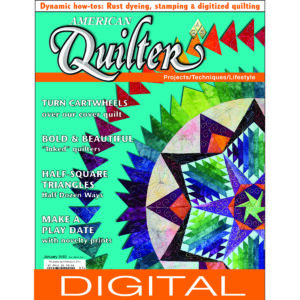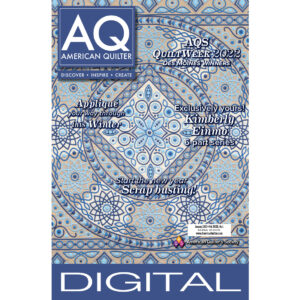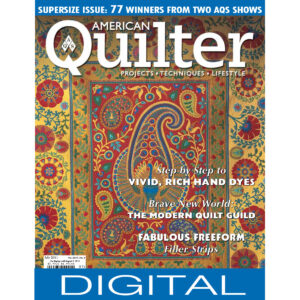Stardust
by Bonnie K. Browning
Perfect project for a beginning quilter.

Size: 36″ x 36″
Finished Sawtooth Star blocks:
Center: 12″ Sawtooth Star in a 24″ Sawtooth Star
Border: 6″ Sawtooth Star in each corner
SUPPLIES:
Fabric:
1/4 yd. Fabric 1, dark for 12″ star background and 24″ star points
1/4 yd. Fabric 2, light for star points
1/4 yd. Fabric 3, medium for 12″ star center
1/4 yd. Fabric 4, light for the 24″ star background
3/4 yd. Fabric 5, contrasting color for border
1/4 yd. For binding (choose any of your fabrics)
Thread to match darker fabric, or choose a medium gray or tan to blend with the fabrics
Backing fabric: 40″ square
Batting: 40″ square
Straight pins
Rotary cutter, mat & 6″ x 24″ ruler
Iron & ironing board
Sewing machine
STEP 1: CHOOSING FABRIC
Select colors you like or that add to your home decor.
Center star (12″) – Three fabrics are used in the 12″ star. Choose a dark color (Fabric 1) for the background, one light (Fabric 2) for the star points, and one medium (Fabric 3) for the center. These same colors are used in the corner stars in the border, but the colors are changed around for more visual interest.
Large star (24″) – Use the dark background (Fabric 1) from the center star and choose a light fabric (Fabric 4) for the background.
Border – Select a fabric (Fabric 5) that blends with the center stars; the border can be light or dark but there should be contrast with the background that touches it.
STEP 2: USING ROTARY TOOLS
Review the basic rules for using the rotary cutter. To protect yourself and others, always slide the blade guard into place as soon as you finish a cut. Cut away from your body. To keep the ruler from sliding, secure the ruler by placing your little finger off the left edge (if you are right-handed). When making a long cut, make the first part of the cut, keeping the rotary cutter in the fabric. Carefully lift your hand and reposition it on the ruler; continue making the cut.

STEP 3: SEAM ALLOWANCES
In quiltmaking, 1/4″ seam allowances are used to sew pieces and units together. Using your machine, determine whether you have a sewing machine foot that sews an accurate 1/4″ seam allowance. Sometimes you may need to change the needle position, or place tape on the foot feed plate to mark the measurement for accurate seam allowances.
STEP 4: CORNER-SQUARE TECHNIQUE
The corner-square technique, using squares and rectangles, is used to create the star points. The same technique is used to make the star points for the stars in three different sizes.
- Fold the squares for the star points in half diagonally with wrong sides together and press (figure A). This folding method saves time by eliminating the need to mark a diagonal stitching line on the fabric.

- Press the squares for the quilt star points (12″ center Sawtooth Star and 24″ Sawtooth Star; border star points will be done in Lesson 5) and lay out the quilt. See quilt assembly below. If your work area allows, leave your quilt laid out for the entire project, placing stitched parts into the layout as you complete each step.
- Open one folded square and place it, right sides together, on a rectangle. Sew diagonally from corner to corner on the folded line (figure B).

- Trim the corner, leaving 1/4″ seam allowance (figure C). Press the corner triangle open.

- Place a second folded square, right sides together on the other corner of the rectangle. Make sure the fold slightly overlaps the first star point at the center of the rectangle edge (figure D).

- Sew on the folded line, trim the corner, and press.
Congratulations, you have just mastered the corner-square technique and made one star-point unit (figure E). All of the remaining star points are made this same way, only the sizes of the squares and rectangles change.

Assembling the Quilt Center
- Stitch the folded squares to make the star points for the center (12″) Sawtooth Star.
- Lay out the star; place the star point units on each side of the center, and add a background square in each corner. Check to make sure the star points are facing outward; the right angles of the star points should touch the center square.
- Sew the rows together for the center star.
Row 1: corner square/star-point unit/corner square
Row 2: star-point unit/ center square/star-point unit
Row 3: corner square/star-point unit/corner square

STEP 5: PRESSING
Press by lifting the iron up and down on the fabric. Ironing with a back and forth motion can cause distortion, especially on the bias of the fabric. Puckers in a stitched seam line can be caused by uneven thread tension. Before you open the pieces, press the seam line to set the stitches, giving a smoother appearance.
- Press seam allowances in opposite directions to reduce bulk and to help align the seam lines for sewing (figure F). Usually seams are pressed toward the darker fabric, but sometimes it is preferable to press toward the lighter fabric. Press a seam before you sew across it again.

- Stitch the folded squares to make the star points for the 24″ Sawtooth Star. (See Step 4.)
- Place a star-point unit on each side of the center 12″ Sawtooth Star, and add a square in each corner.
- Sew the rows together to make the 24″ star:
Row 1: corner square/star-point unit/corner square
Row 2: star-point unit/center 12″ Sawtooth Star/star-point unit
Row 3: corner square/star-point unit/corner square.
Border
- Make four 6″ Sawtooth Stars for the corner, using the corner-square technique in Step 4 (figure G).

- Stitch a 6″ Sawtooth Star to each end of two 6-1/2″ x 24-1/2″ border strips to make two border units (figure H).

- Pin two border strips on opposite sides, right sides together, to the quilt center, and sew.
- Sew one border unit to the top edge of the quilt, and one to the bottom edge, matching the seam lines.
STEP 6: MARKING THE QUILT TOP
The quilt top can be marked for quilting in a variety of ways, depending on the type of quilting. Show a variety of marking tools.
Finishing the Quilt
Mark the quilt, if required, before you assemble the layers. Straight lines can be marked with masking tape, removable fabric marking pencil or pen, or you can use the edge of a foot on your sewing machine as a guide. Circular designs usually are marked with a fabric marking pencil or pen.
STEP 7: ASSEMBLING THE QUILT SANDWICH
Just like a sandwich you eat, a quilt is made of three layers — the backing, batting, and quilt top.
- Layer and baste the quilt sandwich.
- Quilt as desired. Choices of fabric will affect how much quilting is required. Busy printed fabrics only need to have simple quilting because you will not be able to see a fancy design. Save elaborate designs for areas where the fabric is plain and you can see the fruits of your labor. Sometimes adding quilting lines that echo a shape is enough to emphasize the pieced design (figure I).

Ideas for quilting
- Outline the star shapes, quilting in the ditch where there is no seam allowance to sew through.
- Add echo quilting in the star points to emphasize them.
- Quilt plain borders with small stars, squares on point, a cable, or other designs.
STEP 8: BINDING THE QUILT
Prepare binding for the quilt. You will need 1 1/4″ wide strips totaling approximately 160″. For a neat finish, sew the binding to the top of the quilt by machine, mitering the corner; fold to the back and stitch in place by hand.
STEP 9: SIGNING THE QUILT
Documenting each quilt, including the maker’s name, city, and state where quilt was made, and the date the quilt was finished. If a quilt is made for a special gift, add the occasion to the label. Labels can be made using permanent markers, embroidery, or typing on fabric. Be creative and add a design element from the front of the quilt to the label.
STEP 10: HANGING THE QUILT
Make a rod pocket by cutting a strip of fabric 8-1/2″ wide by the finished width of the quilt. Fold each end in 1/4″ twice to enclose the raw edges of the strip and stitch the hems in place. Fold the strip in half lengthwise, right sides together. Sew 1/4″ seam along the raw edge. Turn right side out and press with the seam at the bottom edge of the rod pocket. The rod pocket should fit 1/2″ from the edges of the quilt. Stitch the rod pocket in place on the upper back edge of the quilt just below the binding.
Hang your own Stardust quilt for all to enjoy!
Save
Save
 American Quilter Magazine January 2010 Digital
1 × $6.99
American Quilter Magazine January 2010 Digital
1 × $6.99  American Quilter Magazine January 2023 Digital
1 × $6.99
American Quilter Magazine January 2023 Digital
1 × $6.99  American Quilter Magazine January 2021 Digital
1 × $6.99
American Quilter Magazine January 2021 Digital
1 × $6.99  American Quilter Magazine July 2011 Digital
1 × $6.99
American Quilter Magazine July 2011 Digital
1 × $6.99